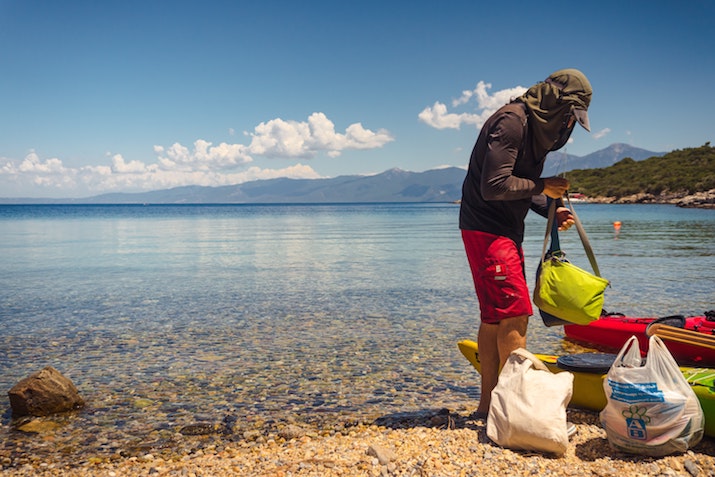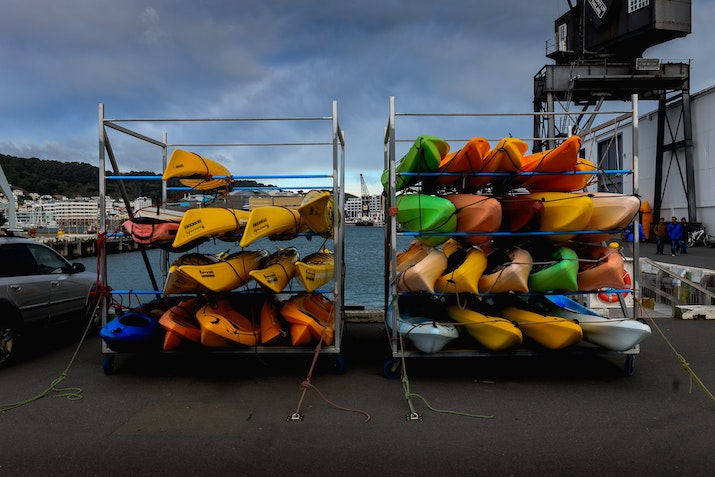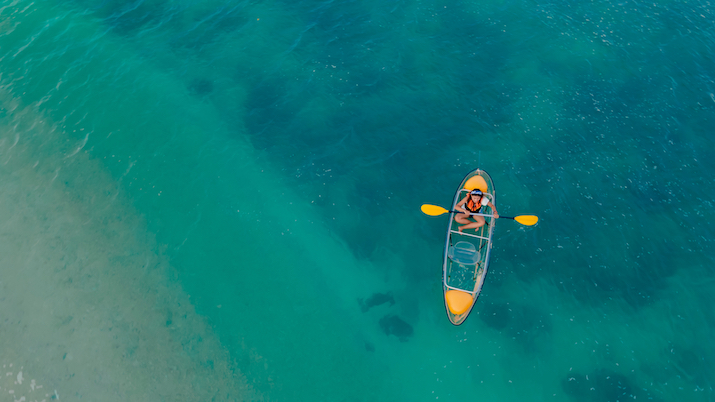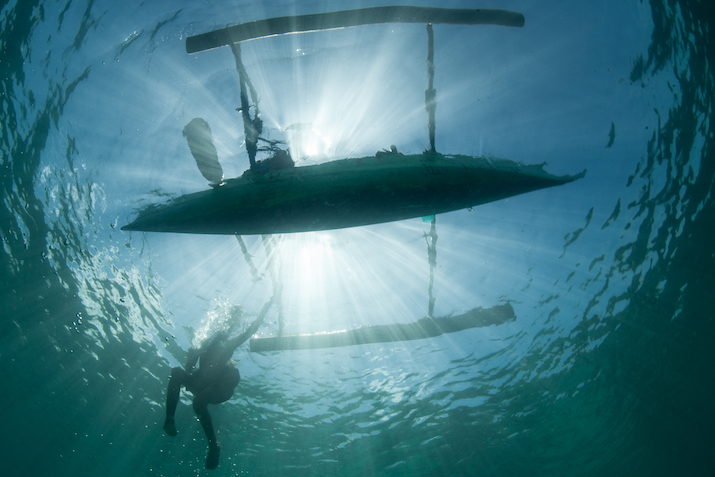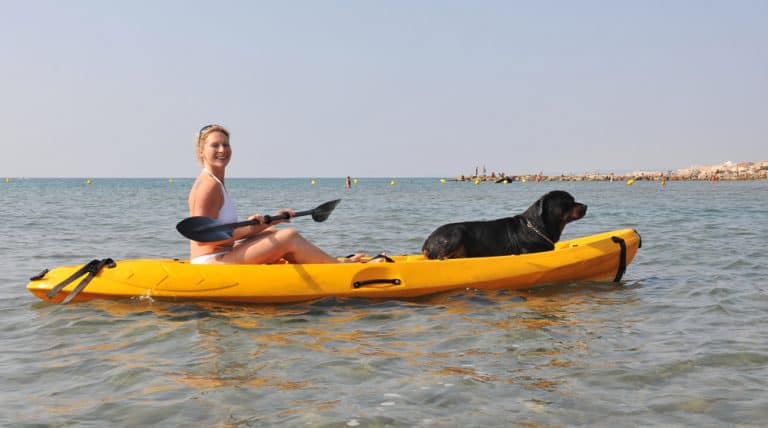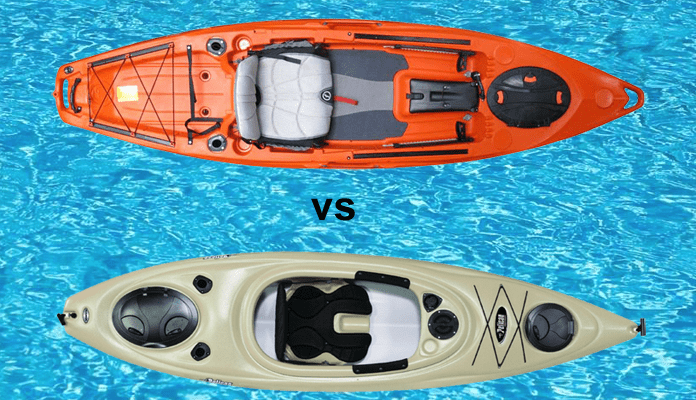Kayaking is one of the most accessible water sports for people of all ages, shapes, and sizes. While there are kayaks out there that can handle some serious weight, is there a weight limit for kayaking in general?
The short answer is yes. Larger paddlers won’t be able to comfortably sit inside and maneuver a smaller kayak or keep it from capsizing if it is loaded down with too much weight.
That being said, knowing the combined weight of paddlers and gear loaded inside a kayak will help you choose a model that will perform well under a heavier load. To put it simply, you just need to make sure that your kayak can handle the combined weight of paddlers and gear without sitting too low in the water.
In this guide, we will discuss a few tips for estimating loaded weight going into your kayak and we will talk about additional ways to improve your kayak’s stability if you are pushing its weight limit.
So let’s weigh all of our options!
Photo by Ali Kazal on Unsplash
Is There A Weight Limit For Kayaking?
Photo by Matthias Groeneveld on Pexels
Technically, yes. The exact number for that limit, however, is going to depend on the maximum weight capacity of the kayak you are using.
In other words, every specific kayak has its own weight limit. Generally speaking, there is no singular weight limit for the sport of kayaking as a whole, so long as you choose the proper kayak and safety equipment.
The combined weight of humans and gear loaded into a kayak should never exceed that personal watercraft’s advertised weight capacity. In fact, we recommend keeping the total weight you put into your kayak below about 80 percent of the maximum capacity of your kayak.
Also, keep in mind that most paddlers carry roughly 30 to 50 pounds of essential kayaking gear every time they go out on the water. The weight of all your gear should always be accounted for when you are determining how much weight your kayak will need to carry.
Average Weight Limits By Kayak Type
Photo by James Coleman on Unsplash
It is important to know that the type of kayak you choose will impact the total weight you can load into it. While there is some variation on these numbers, these are the average weight limits of the most common types of kayaks on the market these days.
- Recreational Kayaks: 200 to 300 pounds
- Touring (Sea) Kayaks: 350 to 450 pounds
- Inflatable Kayaks: 250 to 600 pounds
- Tandem Kayaks: 500 to 700 pounds
- Sit On Top Fishing Kayaks: 275 to 700 pounds
What Influences A Kayak’s Weight Limit?
Photo by Lisa Shivel on Unsplash
While there is no industry standard for kayak weight limits, each manufacturer sets them depending on how they design each of their kayaks. Plus, most companies perform rigorous testing on each kayak model to come up with their weight limits.
That being said, the three major factors that impact your kayak’s weight capacity are:
- Hull length
- Kayak width
- Volume water displaced by the kayak (which is determined by the shape of the hull)
The 80-Percent Rule
Photo by Chavdar Lungov on Pexels
All kayak manufacturers advertise the maximum weight capacity of every kayak model that they produce. If you can’t find the maximum weight capacity for a kayak that you are interested in buying, we recommend looking into community forums.
This can be a really helpful place to find weight capacities for older kayaks (if you are buying used). That said, it is okay to avoid a kayak if you absolutely can’t find the manufacturer’s rating for the weight limit.
Even so, we actually don’t recommend using the advertised weight capacity as the high-water mark for how much weight you can load into your kayak. There are a few important reasons for this (which we will get into later) but, instead, we recommend what we like to call the ”˜80-Percent Rule’.
It is not too technical. It basically states that you should multiply the advertised weight capacity of a kayak by 0.8 to come up with a healthier upper limit for how much weight to load into your kayak.
Using the 80-Percent Rule will help you avoid overloading your kayak and exposing yourself to some of the dangers that we will discuss in the next section.
The Dangers of Overloading Your Kayak
Photo by Ale_Koziura on Shutterstock
To be perfectly honest, most kayaks are not going to sink rapidly if you put 5 to 10 pounds too much weight in them. They just aren’t going to be nearly as effective as they would be if they were carrying the kind of weight they were actually designed for.
Let’s talk about some of the pitfalls of overloading your kayak.
Less Float
The most natural thing that happens when you overload a kayak is that it sits lower in the water. That means less float on waves and it also increases the likelihood of water entering the cockpit from wave action.
While this may be less of a concern if you are paddling one of the best sit-on-top kayaks on a beautiful sunny day, it will be a different story if you are braving a storm in a sit-inside touring kayak.
Decreased Responsiveness
Every kayak relies on a certain level of buoyancy to perform as it was designed. As your kayak sinks lower and lower in the water, it is going to become less responsive to your paddle strokes.
In the best case, this will simply make you slower and it will require more time to get from destination to destination. In the worst case, it can prevent you from avoiding an obstacle that can either damage your kayak or your person.
Muscle Fatigue
If you spend long days on the water, paddling an overloaded kayak is going to be exhausting. Even experienced paddlers need to take breaks every hour or so on longer trips, and padding an overweight kayak is just like carrying too much weight when you are backpacking.
It is going to cause your muscles to fatigue more quickly and put more stress and strain on your elbows, wrists, and shoulders. Increased fatigue and stress on joints will make you more susceptible to injury when paddling an overloaded kayak.
Increased Risk of Sinking
A kayak that sits too low in the water is also at increased risk of sinking entirely. At first, a small bit of water coming into the cockpit of your kayak won’t hurt very much.
This is especially true for sit-on-top kayaks and other designs with self-bailing drain ports in the cockpit. It is more of an issue with sit-inside kayaks that require the use of a bilge pump or sponge to clean water out of the cockpit.
Whether you have a sit on top or sit inside kayak, there is a tipping point at which the weight of the water inside your kayak will be equal to (or greater than) the weight of the water outside of your kayak.
At this point, the buoyancy of your kayak will become ineffective and you will begin to sink.
Hypothermia and Other Cold-Related Illnesses
Sitting in a kayak that is riding exceedingly low in the water also increases the odds that you are going to get wet during your paddle. While hypothermia and other cold-related illnesses may not be a danger if you are always paddling in the middle of the day and you live in a super hot climate, it is a real danger for everyone else.
Even if the sun is shining on a super clear day, getting wet and staying wet for a long period of time puts you at increased risk for hypothermia and other cold-related illnesses. A kayak that isn’t overloaded will sit higher in the water and allow you to stay drier for the duration of your paddle.
Can You Increase A Kayak’s Weight Capacity?
Photo by nymphoenix on Shutterstock
Unfortunately, there is no proven method for increasing a kayak’s weight capacity. While you can certainly make modifications to any kayak out there, it is quite difficult to know just how much those modifications will increase the practical weight limit of your kayak.
Plus, doing so can often void any manufacturer’s warranty that is associated with a new kayak.
However, it is possible to add buoyancy to a kayak which, for all practical purposes, does increase the effectiveness of your kayak under heavier loads.
The main way that people increase the buoyancy of a kayak is to add float bags. Depending on the type of kayak you are working with, float bags can be installed in bulkhead compartments, in the open bow or stern tankwells, or even directly inside the cockpit.
These float bags are essentially airbags that can be inflated to your desired pressure. The main issue with this method, however, is that you will lose valuable storage space in key areas of your kayak.
In addition, you can also consider the environment in which you paddle. Saltwater, for example, is naturally more buoyant than freshwater, which means you will enjoy more float even if your kayak is loaded down close to its weight limit.
How To Make A Heavy Kayak More Stable?
Photo by Ethan Daniels on Shutterstock
While you can not necessarily alter a kayak’s weight capacity, there are some things you can do to make a heavily loaded kayak more stable. Let’s examine a few of those strategies before we wrap things up.
Pack Strategically
When you load a kayak down, you should try to ensure that the weight is evenly distributed side-to-side. In addition, you want as much of the weight to be as close to the center of the kayak (lengthwise) as possible.
This means that your heaviest items should be placed along the centerline of the kayak. They should also be loaded into the forward-most section of your stern storage area and the rear-most section of your bow storage area, respectively.
Using this strategy will help you avoid having a kayak that feels like the stern end is really dragging or the bow is about to nose dive into the water. This will impact your paddle efficiency as well as overall stability.
Add Outriggers
If you are really struggling to keep your kayak upright when it is loaded down, you can consider adding one or even two outriggers to increase your stability. These are either inflatable or rotomolded plastic floats that extend out from the gunwales of your kayak.
They increase your kayak’s overall footprint and will also increase drag (which is why they aren’t great for long-distance paddling). That said, you will be shocked by how much more difficult it is to capsize a kayak that is equipped with an outrigger on either side.
Installing outriggers is also relatively easy and there are several universal designs out there that will be compatible with almost any type of kayak. It also isn’t too difficult to create your own kayak outriggers if you are particularly keen on DIY projects.
Final Thoughts
Photo by Nitish Meena on Unsplash
We think that kayaking can (and should) be accessible to everyone. Your weight should definitely not be a factor that keeps you from enjoying this sport, especially with so many kayak models and adaptable accessories out there these days.
If you are brand new to kayaking, we always recommend taking a course to learn the basic paddle strokes and rescue techniques that you will need to be safe and effective on the water. You can also book a guided kayaking tour in your area for additional instruction in a safe environment.
We hope that you have found the tips and insights we have provided in this guide useful. As always, we wish you the best of luck on all your upcoming kayak adventures!



